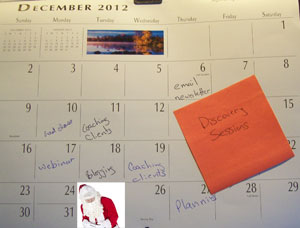Once you’ve created your 90-day goals, you can’t just put them in a drawer and hope they’ll materialize in 3 months. You need to put them into action.
I’ve experimented with a number of systems for implementing my goals. What works best for me – and many other entrepreneurs I’ve spoken to – is to us
Every Sunday evening I pull out my 90-day goals and review what I’d planned to accomplish this week towards those goals. Next I review other obligations I have for the week: work for clients, meetings, personal appointments. I take them all and prioritize them. I have two systems I’ve been alternating between. I haven’t settled on one. In fact one seems to work for me for a while and then stops so I switch to the other.
Use A File Card
The first system is simply using a file card to record all my actions for the week. I write out each item from most important to least. If a task needs to be completed on a certain day I write that next to the task. I keep the card in front of my computer and check off each item as I complete it. Since I like lists, and more importantly, I like checking off completed tasks, this is an easy planning system for me to use.
Try Time Blocking
Occasionally I need more structure to keep on track. That’s when I switch to time blocking. This involves a one page chart with each day of the week divided into half hour segments. I write down my tasks in specific time blocks. For example, I may have checking email from 8 to 8:30, writing my blog post from 8:30 to 10, marketing from 10:30 to12 and finishing a project for a client from 1 to 3.
The key to time blocking, is to be sure to include personal items as well as business related tasks. For example, your weekly Pilates class or going bowling with your kids should be blocked in as well. This helps you keep more balance in your life. It also means if a client asks to meet when you’d planned to go bowling you won’t forget your kids. You can simply say you already have an appointment at that time and suggest an alternative.
Another thing to consider when using the time blocking system is to make sure you don’t over-plan each day. Leave some unscheduled time to allow for unexpected interruptions, tasks that take longer than expected and breaks. Some people suggest leaving as much as 25 to 50 percent of your day unplanned.
If you get all your required tasks done in the appointed time and nothing unexpected comes up you have some choices: you could start on the next day’s tasks, do some additional marketing, or take some time to smell the roses.
When to Switch Planning Methods
When I’m really focused, efficient and on a roll, the file card method of planning seems to work well. I don’t need a lot of structure to keep myself getting things done. I can just look at the list and get moving.
Other times I’m not quite so focused. I need to be “told” when to do certain tasks. That’s when I need to use the time blocking. I don’t need to think about when to do things, I just look at my schedule and get started.
Whatever method you use to create a weekly plan, make sure you’re using your 90-day goals as a starting point. It’s easy to fill your week with busywork – tasks that fill your day but don’t move you forward to your goals. If you stay focused on your bigger goals and make sure you take actions each week towards these goals, you’ll achieve them sooner than you think.
Andrea J. Stenberg





